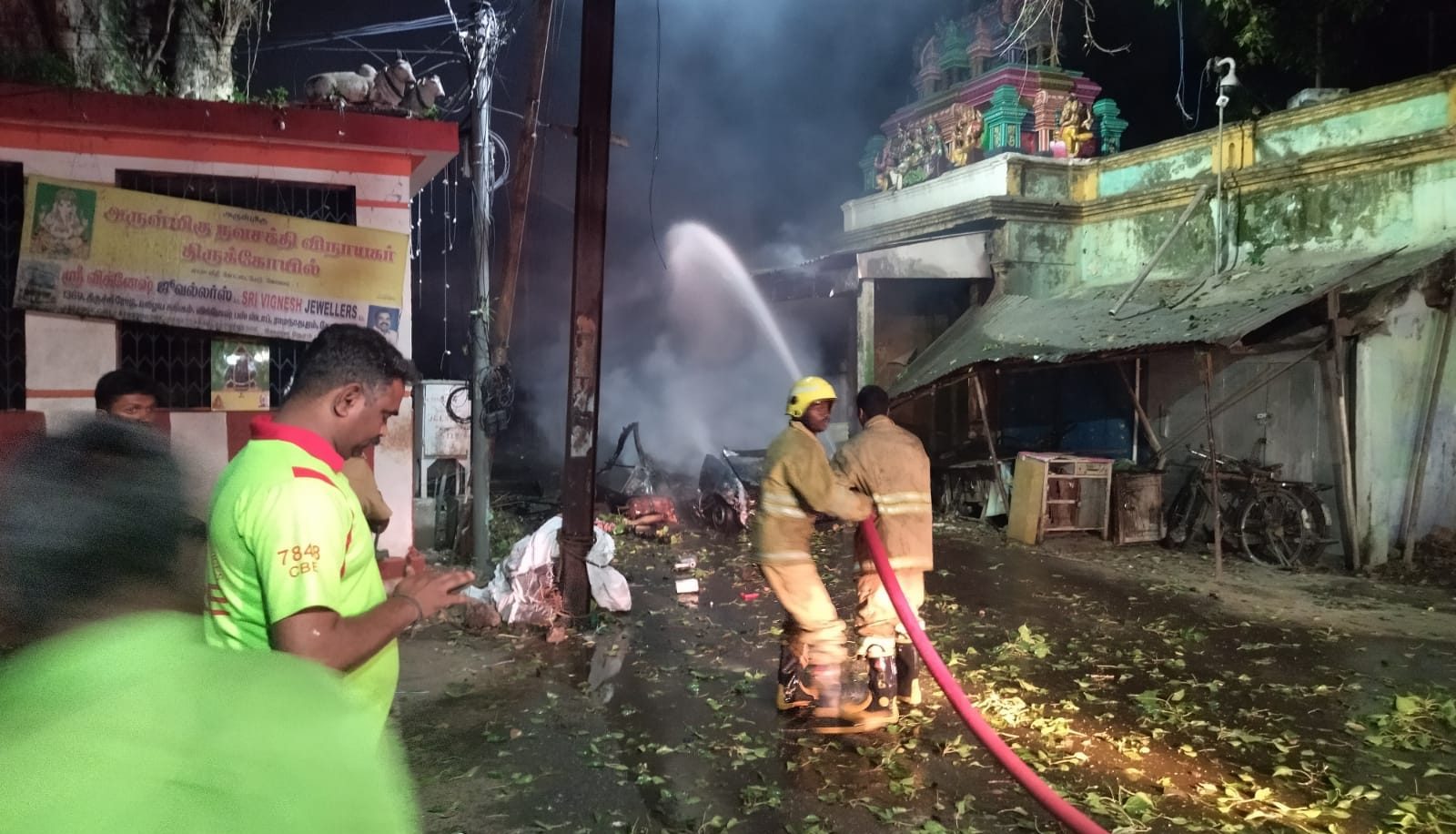In 2019, NIA questioned Jameesha Mubin after he attended sermon classes held by members of an alleged terror module.

Firefighters at the scene of the Coimbatore blast. (Supplied)
On 23 October, at around 4 am, an LPG cylinder kept inside a Maruti 800 car exploded near Kottai Eswaran temple in the Ukkadam area of Coimbatore. The driver of the car, 29-year-old Jameesha Mubin, died in the blast.
Hours after the incident, what was initially reported as an LPG cylinder blast, became part of a suspected act of terror with the police recovering 75 kgs of low-intensity explosive material like potassium nitrate, aluminium powder, charcoal, and sulphur from Mubin’s house.
Nails, marbles and other material used to stuff crude bombs with, were also found in the gutted car.
The police also recovered a note from Mubin’s house which had names of at least five important locations in Coimbatore, which they believe could have been potential targets for an attack: The district collector’s office, office of the police commissioner, Victoria Hall, railway station, and race course.
The Coimbatore police, which identified the deceased as Mubin within hours of the explosion, also found that he was questioned once by the National Investigation Agency (NIA) in 2019. However, no case was registered against him at the time.
This raised more concerns about the nature of the blast that took place on the eve of Diwali.
According to Coimbatore police, Mubin was an engineering graduate and lived in Ukkadam, often described as a communally sensitive area in Coimbatore with a significant Muslim population. He has two children and a wife, who is speech and hearing impaired. The cops said his family stayed on and off with him.

29-year-old Jameesha Mubin. (Supplied)
A senior police official, who spoke to South First on the condition of anonymity, said that, in 2019, after the Sri Lankan Easter bombings, the NIA had questioned Mubin and few others from Coimbatore as they had attended one of the bayan (sermon) classes held by the members of the suspected terror module led by Azharuddin.
Azharuddin had been arrested for his alleged ties to Zahran Hashim, one of the masterminds of the serial Easter bomb attacks in the island nation.
The NIA, however, let Mubin go due to lack of any prosecutable evidence against him.
Even though he was not arrested, the senior official claimed that subsequent alerts were sent to the police about Mubin and others as they were found to have been “radicalised” and “inspired by ISIS modules”.
The officer pointed out that an alert was issued as recently as July 2022.
The Ministry of Home Affairs too, on 18 October, warned of a potential attack in the view of the Union government banning the Popular Front of India .
In addition to the interrogation by NIA, the senior official also claimed that Mubin had visited Kerala to meet Azharuddin and Rashid Ali, a man who is lodged in a prison in Thrissur, after being accused in the Kanakamala ISIS case, in which the members of the Ansar-ul-Khilafah group were allegedly plotting terror attacks in Kerala and Tamil Nadu.
Though the initial investigation into the car blast was carried out in a prompt manner by the Tamil Nadu police, many are also raising questions as to whether the intelligence inputs on Mubin and others were looked into seriously.
The officials also recovered a picture from Mubin’s WhatsApp account which read: “If the news about my death reaches you, forgive my mistakes, hide my faults, participate in Janaasa (funeral) and pray for me.”
The police, however, say it is unlikely that the explosion was a case of a suicide attack.
Tamil Nadu Director General of Police Dr C Sylendrababu on Sunday told reporters that Mubin was trying to escape from a police check-point manned by a sub-inspector and constables when the car exploded. But whether the LPG cylinder kept inside the car went off accidentally or deliberately still remains unclear.
Late on Monday, 24 October, Diwali day, the police recorded the arrest of five Coimbatore residents: Muhammad Thalka, Muhammad Azharudheen, Muhammad Riyas, Firoz Ismail and Muhammad Nawaz Ismail —. all suspected associates of Mubin.
The arrests were made on the basis of CCTV footage that emerged earlier in the day purportedly showed Mubin, along with Riyaz, Nawaz and Firoz, carrying heavy objects using sacks from the former’s residence hours before the LPG blast.
According to Coimbatore Police Commissioner V Balakrishnan, the heavy objects they lifted — knowing well what they were for — were two LPG cylinders and three drums/cans.
In the case of the other two men who were arrested, one of them had provided the Maruti 800 car to Mubin, and the other person had helped in coordination.
A day after the attacks, on Tuesday, the Coimbatore police invoked Unlawful Activities (Prevention) Act (UAPA), a stringent anti-terror law, in connection with the case.
Sections relating to criminal conspiracy and promoting enmity between two groups were added to the existing First Information Report which was initially filed under CrPC 174 (unnatural/ suspicious death) and Section 3 (a) of the Explosive Substances Act.
With the police invoking UAPA, and given the serious nature of the incident, sources told South First that the NIA will most likely take over the investigation in the case very soon.

Apr 16, 2024

Apr 13, 2024

Apr 13, 2024

Apr 13, 2024

Apr 12, 2024